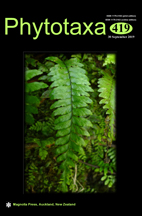Abstract
Five taxa in the genus Neidium, N. iridis, N. beatyi sp. nov., N. vandusenense sp. nov., N. collare sp. nov. and N. lavoieanum sp. nov. are documented from a pond and stream system in the VanDusen Botanical Garden, Vancouver, Canada. Neidium beatyi is a large linear species with multiple longitudinal canals and sagittate apices. The areolae are occluded by finger-like silica extensions on the external surface. This taxon is distinguished from Neidium iridis by the number of longitudinal canals (>5), shape of the valve apices, and smaller size. Neidium vandusenense is broadly linear with distinct rostrate apices. Two-three longitudinal canals are present along each margin. Plastid rbcL sequence data associates this taxon with N. amphigomphus. Neidium collare is an elliptic lanceolate taxon with one longitudinal canal. This taxon is genetically related to N. bisculatum sensu lato, but with a different shape form. Neidium lavoieanum has a valve shape form similar to Neidium potapovae, but is larger and genetically similar to N. productum sensu lato. The five Neidium taxa were observed in a small stream next to Lake Victoria (pond) in the VanDusen Botanical Garden Vancouver, Canada. The water was mildly alkaline with a pH of 7.86, a conductance of 163 µS/cm, higher nutrient loads and low metal content.

